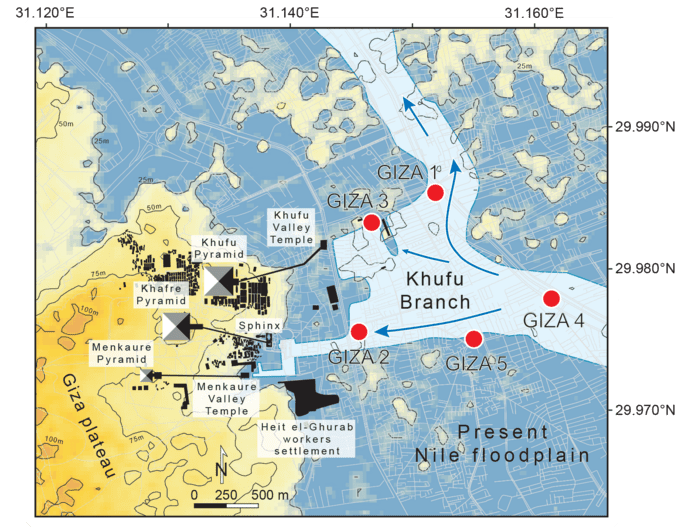The construction of Egypt’s great pyramids of Giza some 4,500 years ago is one of the world’s greatest achievements. Among the many questions and complexities surrounding the pyramids, however, is how their vast “building blocks” were hauled to the construction site. It turns out, we can thank a long-lost branch of the River Nile.
When we imagine the pyramids of Giza today, we expect to see them surrounded by a vast plain of sand with the Greater Cairo metropolis sprawling behind them. The main body of the Nile is currently some 8 kilometers (5 miles) away, which is a vast distance if you’re lugging huge quantities of stone across the sand.
Over 4,000 years ago, however, a now-defunct arm of the Nile known as the Khufu branch could be found carving just past the site of the Giza pyramid complex. It’s long been suspected that the Khufu branch was a vital vein of ancient Egpyt, aiding its workers to transport materials to the pyramids from elsewhere. However, its history has remained little understood.
As reported in the Proceedings of the National Academy of Sciences, researchers from France managed to gain a detailed history of this river section from pollen grains extracted from the floodplain.
Map shows how the Khufu branch of the River Nile In Egypt formerly reached the edges of the Great Giza pyramid complex. Image credit: PNAS
By tracking the growth and demise of over 61 different plants along the flood plain, they showed the rise and fall of water levels in the river’s branches over 8,000 years of ancient Egyptian history.
Most notably, it showed that the waters of the Khufu branch rose significantly during the African Humid Period, which spanned from 14,800 years ago until 5,500 years ago.
However, water levels of the Khufu branch appear to have been relatively high for some time after the African Humid Period, allowing the river to remain navigable until the Great Pyramid of Giza, dedicated to pharaoh Khufu, was constructed around 4,500 years ago.
At some point, it’s possible this lost arm of the Nile may have reached as far as the Great Sphinx of Giza, which stands proud at the front of the complex.
While it’s clear that the Khufu branch of the Nile could have helped transport construction materials closer to the Giza pyramid complex, many other details around the pyramids’ construction are still uncertain.
The Great Pyramid of Giza originally stood at 146.6 meters (481 feet) tall, consisting of over 2.3 million large stone blocks weighing 6 million tonnes in total. Theories exist, but there’s currently no solid idea of how the colossal blocks were placed one on top of another in a highly complex structure featuring a warren of inner passages and tombs.
And no, it certainly wasn’t with the aid of aliens.
Source Link: Nile Riverbed Clues Help Explain The Mystery Of Egypt's Pyramid Construction
